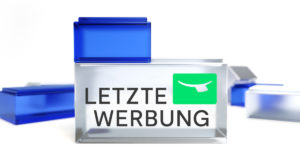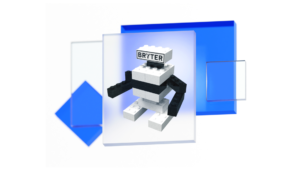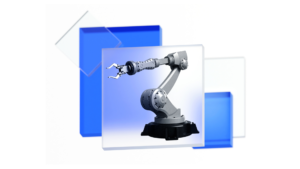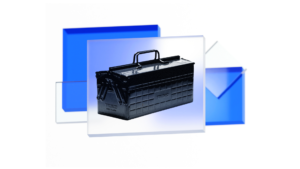Digital everywhere
Consumers got used to this and now expect the same thing when working for or with enterprises. Service delivery is going digital, and leverages technology to offer creative formats for the jobs enterprise workers are doing.
Digital transformation in the enterprise means you can replicate assets (such as documents or an inventory), knowledge (explicit knowledge such as information in databases, but also tacit knowledge that sits with industry experts) or tasks through technology.
However, an enterprise is not a collection of marbles or a pile of sand: it’s a multi-faceted organism. Tasks, people and information are different in many departments. Change never happens at the same pace. And so, digital transformation hasn’t covered all areas of the enterprise yet. At some places, technology is still struggling to get a grip…
ITSM: a star is born

The digital transformation of the enterprise is an ongoing process that has converted many minds over the years but is becoming more challenging at every next step it takes.
It started in the ’90s with IT services. IT services were easy to digitize and automate because they are relatively straightforward and similar across many enterprises. Ticketing, intake tools, service lines and portals all proved incredible value for communication and collaboration within IT teams. The technology facilitating this was shaped into a category called ITSM, short for IT service management. Gartner published its first ITSM magic quadrant in 2007. In 2008 it added ServiceNow, a company that recently surpassed $100bn in market cap. And it’s only one of the large companies that have ridden this wave, such as Microsoft, BMC, IBM and Oracle.
The benefits for ITSM are clear: service workflows reduce non-human interaction and handover times, lower costs for IT services, increase service levels, deliver support faster, are less error-prone and have a lower chance of requests falling through the cracks. Additionally, they also allow to measure and manage, and analyze improvement opportunities, enabling companies to plan better and to allocate human capital in a smarter way.
CSM or ITSM’s younger sister
More and more services were added from 2010 and onwards. Next up: CSM (customer support management), personified by companies such as Zendesk (recently surpassing $15bn market cap). By automating customer services, 24/7 seamless support was made possible, and the processing of tickets was accelerated. Companies gained the ability to service huge amounts of customers across time zones at reduced costs. And finally, as in ITSM, companies learned how to measure customer service KPIs and gain valuable insight. This second step is already more challenging but also more rewarding. The direct impact of improved customer support is higher and many of the services customer support offers are more valuable than many of the ITSM workflows that were digitized. A modern layer that has gained hype in recent years is the chatbot (sometimes called ‘conversational agents’), which is being used in customer support but also marketing to digitize conversations.
Expert services: the next generation
Finally, more and more enterprises have adopted technology and are now moving into unprecedented territory: the so-called expert services. Digitization tends to be more challenging, but all the more valuable when working. This is where service automation comes in. Service automation applies the lessons learned from the ESM ecosystem to valuable enterprise areas and adds the ingredients required to make it work for complex services such as regulatory work.
ITSM got a foothold enterprise, but service automation is fully embedded in the business service teams and less in the technical teams. Remarkably, business services could be either external (an enterprise interacting with a customer) or internal (one department interacting with another department): service automation provides tremendous value for both.
So why is this ‘the next generation’? Service automation can be seen as the next level of enterprise services. It’s one of the most valuable developments in digital transformation because digitizing business areas is a lot more challenging. They are less standardized and hard to replicate across teams. They need to be adjusted for different companies. On the other hand, having them in a digital and automated format empowers the knowledge distribution and servicing of some of the most valuable and time-critical resources in a company.
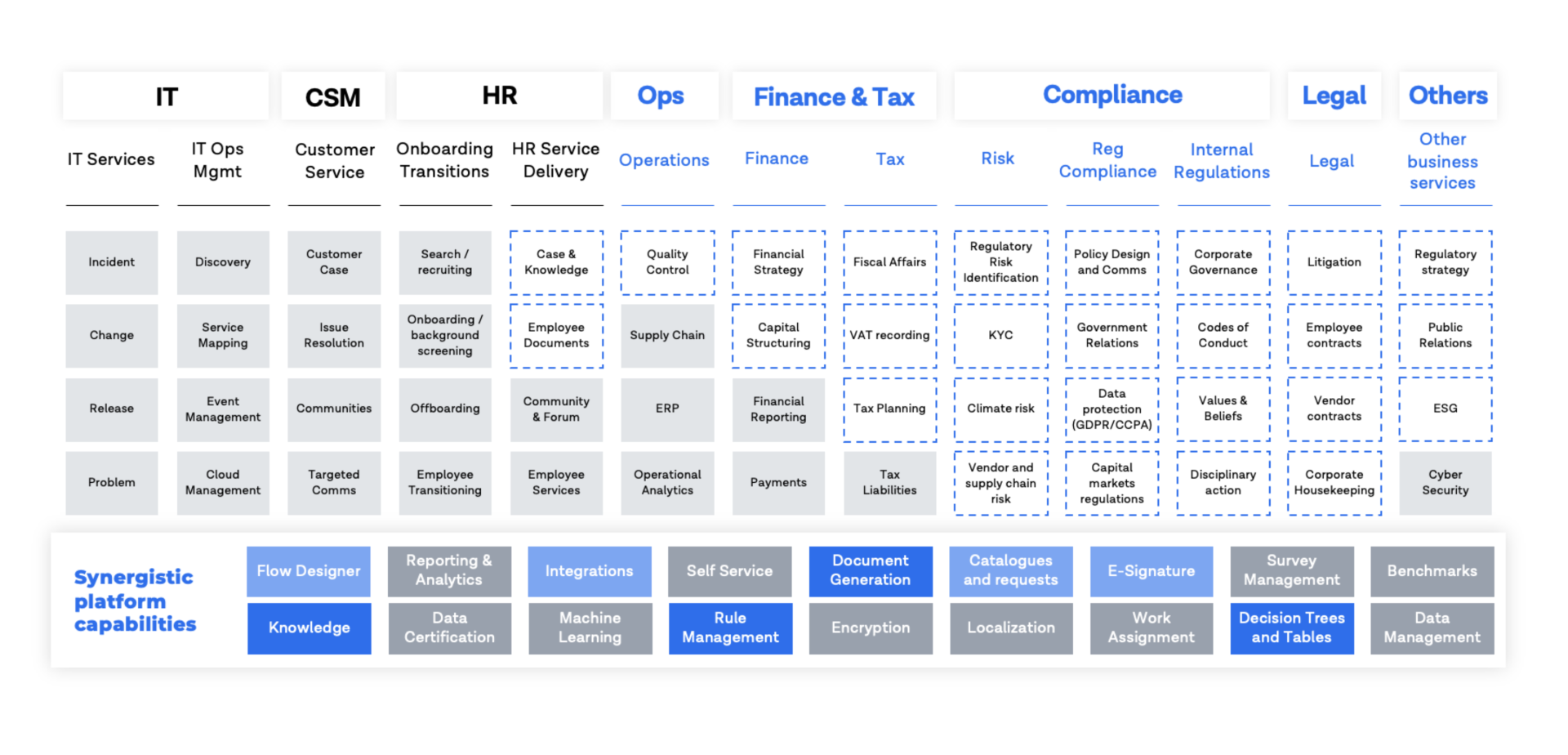
For example, some of the most costly teams are those assessing risks in transactions. It’s a manual process that needs to be done fast and immediately. Service automation allows risk assessments to be available seamlessly to everyone who needs it; every time they need it. And finally, unlocks other benefits that weren’t possible before:
- Risks can be calculated more precisely and breaches can be averted
- Risk assessment is documented and teams can optimize the process
- The team is more agile and can tackle more assessments. Cost centers are turned into scalable services that not only cut costs but reduce the service barriers that hinder business growth
The in-house legal department is another example of an area within an organization that can greatly profit from automated expert services. Usually responsible for handling an array of requests ranging from simple tasks such as guiding users to legal resources to updating all master service agreements according to newly published legislation, efficiency plays a vital role in the daily tasks performed. Through the BRYTER Virtual Legal Assistant, incoming legal requests are channeled to customized self-service applications or directly escalated to the responsible legal expert. Our legal and compliance front door removes existing bottlenecks in expertise and allows experts to focus more on urgent requests. The legal department can further utilize the audit trail created from incoming legal requests to spot trends and build legal workflow automation solutions for the most heavily requested services. Our customer GEA, a global manufacturing company, is able to build out these tools for the global enterprise – tools that are available to every user in their company.
One example of a self-service tool that is frequently built on BRYTER is a Gift & Hospitality Advisor. The Gift & Hospitality Advisor helps employees navigate the company’s jurisdiction-specific and often lengthy policies on accepting gifts and invitations. The employee is guided through a questionnaire that, based on the given inputs, is able to determine the applicable policies. As a result, the employee receives clear instructions that are accessible around the clock. The responsible manager or department is notified of the result and able to track the type and amount of gifts and invitations assessed. The open architecture of the BRYTER platform enables companies to easily adjust and expand the application to reflect updated policies.

ESM and service automation: a love story
One more important observation can be made: ITSM, CSM, service automation are all interconnected. It’s possible to attach more enterprise services to existing ones. Companies running ServiceNow or other intake tools or communication tools such as Microsoft Teams can expand them into the other verticals as well by using a service automation platform. Enterprises can now finally play the digital transformation end-game.
To summarize the benefits, service automation:
- speeds up and reduces the costs of service delivery
- makes your self-service possible 24/7
- frees business experts from mundane work. By focusing on more complex work, their role changes from a mere ‘phone advisor’ to a strategic manager of service delivery
- allows building service applications faster and cheaper than through IT
- is less error-prone than manual service delivery
- is the first step towards measuring and gaining insight into the effectiveness of your service delivery
- keeps your services in one central, accessible place, functioning as a system of record for your rules and expert knowledge
Digitizing business areas is challenging and service automation can be seen as the next level of enterprise services. Book a demo to discover how BRYTER can transform your business.

